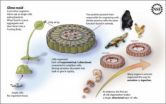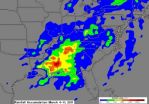(Press-News.org) Providing clues into why the severity of a common parasitic infection can vary greatly from person to person, a new Johns Hopkins study shows that each one of three strains of the cat-borne parasite Toxoplasma gondii sets off a unique reaction in the nerve cells it invades.
Past research suggests that the parasite, estimated to infect 25 percent of people worldwide, can trigger or exacerbate psychotic symptoms and schizophrenia in genetically predisposed people.
The findings of the new study, published in the March issue of the journal Infection and Immunity, help explain why the infection causes serious disease in some but not in others and clarify its role in psychiatric disorders, the researchers say.
"We already know that toxoplasmosis can play a role in some psychiatric disorders, but up until now we didn't know why. Working with human nerve cells, our study shows the exact alterations triggered by each strain that can eventually manifest themselves as symptoms," says senior investigator Robert Yolken, M.D., a neurovirologist at the Johns Hopkins Children's Center.
The researchers injected human nerve cells with the three most common toxoplasma strains, each of which caused a different pattern of gene expression. One of the most basic functions in all living organisms, gene expression occurs when a gene is switched on to release a substance that tells cells what to do or not do, determining the cells' biologic behavior. Gene expression can be turned on and off, stepped up or down by various factors, including viral and bacterial invasions.
Cells infected with toxoplasma type I -- the most virulent strain in mice -- had the greatest impact on gene expression, altering more than 1,000 genes, 28 of them linked to brain development and central nervous system function and 31 others to nerve impulse and signaling.
Cells injected with the less virulent types II and III had low and moderate levels of gene expression. Infection with toxoplasma type II affected 78 genes, some of which were related to growth, certain hormones and circadian rhythm, while type III altered 344 genes, some of which were linked to metabolism.
A handful of genes were affected by all three strains, notably a gene called VIPR2 that regulates neurotransmitters and nerve signaling and may play a role in schizophrenia, the researchers say.
If these findings are confirmed in clinical studies with people, they could help physicians predict the severity of an infection by strain type and tailor treatments accordingly, the researchers say.
"While disease course in humans is often more unpredictable than what we see in the controlled setting of a lab, these results give us a fascinating first look into the distinct genetic cascade of reactions that each strain can unlock and may one day serve as the basis for individualized treatment of symptomatic infections," says lead investigator Jianchun Xiao, Ph.D., a neurovirologist at the Stanley Division of Developmental Neurovirology at Johns Hopkins.
A 2008 study by Yolken and colleagues revealed that toxoplasma infection increases the risk for schizophrenia and could precipitate the disease in genetically predisposed people, a classic example of how genes and environment come together in the development of disease.
Most infections with toxoplasma occur early in life following exposure to the parasite from cat feces or undercooked beef or pork.
Farm animals and rodents also get infected, but the parasite reaches full sexual reproduction only in cats. Infections rarely cause symptoms, but the parasite remains in the body and can reactivate after lying dormant for years.
###
Co-investigators on the study included Lorraine Jones-Brando, M.D., and C. Conover Talbot Jr., both of Johns Hopkins.
The research was funded by the Stanley Medical Research Institute.
Related:
Toxoplasma Infection Increases Risk of Schizophrenia, Study Suggests http://www.hopkinschildrens.org/newsDetail.aspx?id=1830&LangType=1033&terms=Robert+Yolken
"Brain Bank" To Foster Research, Treatment of Major Psychiatric Disease http://www.hopkinschildrens.org/newsDetail.aspx?id=8029&terms=Robert+Yolken
Robert Yolken
http://www.hopkinschildrens.org/staffDetail.aspx?id=3156&terms=Robert+Yolken
Toxoplasmosis: The strain explains severity of infection
2011-03-15
ELSE PRESS RELEASES FROM THIS DATE:
New research focuses on prion diseases
2011-03-15
New research by Chongsuk Ryou, researcher at the UK Sanders-Brown Center on Aging and professor of microbiology, immunology and molecular genetics in the UK College of Medicine, may shed light on possible treatments for prion diseases.
Prion diseases, which include Creutzfeldt-Jakob disease in humans and bovine spongiform encephalopathy ("mad cow" disease) in cattle, are caused by prions — unconventional pathogens composed of infectious protein particles and resistant to conventional sterilization procedures. Presently there is no known agent or procedure that can halt ...
Teens and young adults with cancer face unique challenges and require targeted care
2011-03-15
New Rochelle, NY, March 14, 2011–Adolescents and young adults are neither children nor adults and those affected by cancer require targeted care that crosses the boundaries between pediatric and adult oncology, according to several pioneers in this still-developing field of adolescent and young adult oncology. An illuminating roundtable discussion by these experts will be published in the premier issue of Journal of Adolescent and Young Adult Oncology, a multidisciplinary peer-reviewed publication of Mary Ann Liebert, Inc. (www.liebertpub.com). The Roundtable has been published ...
How the slime mold gets organized
2011-03-15
The so-called cellular slime mold, a unicellular organism that may transition into a multicellular organism under stress, has just been found to have a tissue structure that was previously thought to exist only in more sophisticated animals. What's more, two proteins that are needed by the slime mold to form this structure are similar to those that perform the same function in more sophistical animals.
Shortly after an animal embryo forms, it develops a single layer of cells that, shaped like a hollow ball, is empty at its center. Acting as a kind of "man behind the curtain" ...
Combining 2 peptide inhibitors might block tumor growth
2011-03-15
COLUMBUS, Ohio – A new study suggests that combining two experimental anticancer peptide agents might simultaneously block formation of new tumor blood vessels while also inhibiting the growth of tumor cells.
This early test of the two agents in a breast cancer model suggests that the double hit can stifle tumor progression, avoid drug resistance and cause few side effects, say researchers at the Ohio State University Comprehensive Cancer Center – Arthur G. James Cancer Hospital and Richard J. Solove Research Institute (OSUCCC – James) who developed the agents and evaluated ...
New high-resolution carbon mapping techniques provide more accurate results
2011-03-15
HILO, Hawaii—A team of scientists from the Carnegie Institution for Science's Department of Global Ecology and the USDA Forest Service's Pacific Southwest Research Station (PSW) has developed new, more accurate methods for mapping carbon in Hawaii's forests. Their research appears in an online issue of the journal Frontiers in Ecology and the Environment.
The growing market for private and public entities to purchase carbon offsets has led to a need to find better monitoring techniques to accurately quantify the amount of carbon (C) held in our nation's forests. Combining ...
NASA's Hubble rules out 1 alternative to dark energy
2011-03-15
Astronomers using NASA's Hubble Space Telescope have ruled out an alternate theory on the nature of dark energy after recalculating the expansion rate of the universe to unprecedented accuracy.
The universe appears to be expanding at an increasing rate. Some believe that is because the universe is filled with a dark energy that works in the opposite way of gravity. One alternative to that hypothesis is that an enormous bubble of relatively empty space eight billion light-years across surrounds our galactic neighborhood. If we lived near the center of this void, observations ...
TRMM maps flooding along US East Coast from massive storm
2011-03-15
The massive rain storm that stretched from New York to Florida last week dropped some record rainfall and NASA's Tropical Rainfall Measuring Mission (TRMM) satellite measured that rainfall from space. Those rainfall totals were assembled in a "rain map" created at NASA's Goddard Space Flight Center in Greenbelt, Md.
Although the heaviest rainfall last week was in the southern United States, flooding was reported in states from Louisiana to northern New York. A rainfall analysis was created made by merging precipitation data from multiple satellites. This Multisatellite ...
Silicon spin transistors heat up and spins last longer
2011-03-15
SALT LAKE CITY, March 15, 2011 - University of Utah researchers built "spintronic" transistors and used them to align the magnetic "spins" of electrons for a record period of time in silicon chips at room temperature. The study is a step toward computers, phones and other spintronic devices that are faster and use less energy than their electronic counterparts.
"Electronic devices mostly use the charge of the electrons - a negative charge that is moving," says Ashutosh Tiwari, an associate professor of materials science and engineering at the University of Utah. "Spintronic ...
Parental monitoring of opposite-gender child may decrease problem drinking in young adults
2011-03-15
Young adults whose parents monitor their social interactions may be less likely to display impulsive behavior traits and to have alcohol-related problems, a new study suggests. The level of monitoring is linked to parenting style, and the link is stronger with the parent of the opposite gender.
This study is one of the first to explore the link between parenting style and parental monitoring, as well as to explore the monitoring style of each parent individually, says Julie A. Patock-Peckham, Ph.D., Assistant Professor of Psychology & Neuroscience at Baylor University ...
New research demonstrates language learners' creativity
2011-03-15
(Washington, DC) New research published in Language, the journal of the Linguistic Society of America (LSA) firmly establishes that language learning goes well beyond simple imitation, and in fact that language learners are quite creative and remarkably smart. Not only are learners able to generalize grammatical restrictions to new words in a category – in this case, made-up adjectives – but they also do not learn these restrictions in situations where they can be attributed to some irrelevant factor.
This point is driven home in an article, "Learning what not to say: ...



